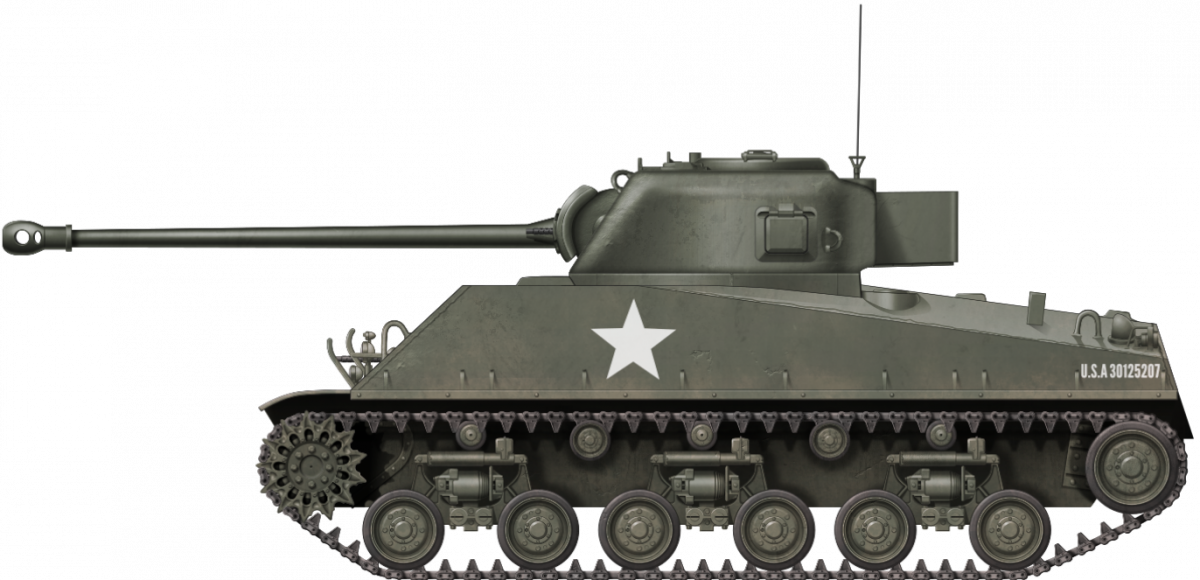 United States of America (1944-1945)
United States of America (1944-1945)
Medium Tank – 100 Built
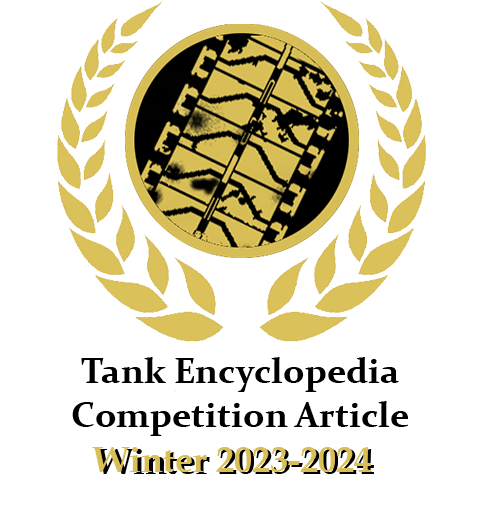
The Sherman Firefly, equipped with the potent British 17-pounder gun, became a formidable asset during World War II. Yet, the United States did not embrace this modification. Factors such as skepticism regarding British tank adaptation practices, differences in strategic doctrine favoring tank destroyers, and the development of their own 76 mm gun contributed to the initial reluctance. The story of how the US eventually sought Fireflies reveals a journey marked by changing battlefield needs, evolving perceptions about tank weaponry, and logistical considerations. Understanding this shift sheds light on the complexities of wartime decisions and technological adaptations.

The Sherman Firefly

The Sherman Firefly was the British project to mount the QF 17-pounder 3-inch (76.2 mm) gun onto the Sherman turret, which was ordered into production by Winston Churchill after other projects mounting the 17-pounder gun in other tanks failed. Converted exclusively from tanks seriously armed with the 75 mm M3 gun, the main difference compared to a normal Sherman consisted of the gun, the position of the radio, the ammunition layout, and the absence of the co-driver and their machine gun. Initially, putting a 17-pounder gun into the Sherman’s turret was considered impractical, as it had a large recoil track. This was overcome using a new recoil system, using stacked recoil cylinders. These and other modifications led to the Mark IV design of the 17-pounder.

The gun’s considerable recoil caused the turret layout to change drastically. The radio had to be moved into an armored box on the rear of the turret to ensure it could be operated safely. The armored box also acted as a counterweight for the new gun. In addition, the loader’s position was relocated, and a new loader’s hatch was added to the roof of the turret due to the gun’s size. The changes to the hull were related to the ammunition layout because the rounds were larger and required more space. To increase the storage space for 17-pounder’s ammunition, the co-driver was eliminated, and the space was used for ammunition stowage.
The Firefly was almost exclusively converted from M4 and M4A4 tanks and was a vital part of the British and Commonwealth forces.
Types of Sherman
M4
The M4 Sherman was the third type of Sherman produced. It used the R975 radial engine and a welded hull with both small and large hatch variants. The engine used eighty octane fuel to develop 485 bhp at 2,400 revolutions per minute and gave the engine deck its distinctive hatch. It featured a 7.62 mm (0.3 in) M1919A4 machine gun mounted in the front of the hull, which was used by the co-driver. The same type of machine gun was coaxially mounted, which was used by the gunner. Very early models had a pair of fixed machine guns in the hull, but these were quickly eliminated. They also mounted an M2 12.7 mm (0.5 in) caliber machine gun on the turret roof for anti-aircraft defense. It was equipped with either the M3 75 mm gun or M4 105 mm howitzer. Five manufacturers produced the M4, which was one of two tanks converted to Fireflies for the British Army.

M4A3
The M4A3 was the United States Army’s preferred Sherman, and a variant would be the last Sherman in US Army service. The M4A3 used a welded hull with both large and small hatch variants. It used the Ford GAA V8 engine explicitly designed for tanks. It developed 500 hp at 2,600 rpm with 1,050 Ib-ft of torque at 2,200 rpm. It was armed with either the M3 75 mm gun, M1, M1A1, M1A1C, M1A2 76 mm guns, or the M4 105 mm howitzer, with a M1919A4 7.62 mm (0.3 in) machine gun in the front of the hull and one also coaxially mounted beside the main gun. An additional M2 12.7 mm (0.5 in) caliber machine gun was mounted on or near the commander’s cupola. In total, 12,596 were built throughout the war and used in World War 2 and into the Korean War. This type was not converted to Sherman Fireflies for the British Army.


Hatch Types
Direct Vision
Sherman tanks were initially produced with small hatches and direct vision ports. These ports were small slits below the hatch that could be closed off by a hinged armored block. These ports created a weak point in the armor and allowed shrapnel to enter the tank, possibly injuring the driver. The direct vision ports were ordered to be removed from production on 24 June 1942, but it took several months to accomplish, meaning several thousand were built. These were later welded and plated over if the tank entered combat or were remanufactured.


Cast Hood
When direct vision hoods were removed from production, new designs were introduced that were longer and offered better ballistic protection. The switchover happened around the latter half of 1942 or throughout 1943. Different manufacturers used various designs, with the main difference being the width of the casting. The M4 and M4A2 used narrower castings, while Chrysler’s M4A4s and Ford’s M4A3s used wider castings.


Large Hatch
The last significant change to Sherman’s hatches was made around late 1943 to 1944, with the introduction of larger hatches. These reduced the time the crew took to enter and exit the tank and decreased the number of weak points in the frontal armor. This was achieved by decreasing the number of welds needed using a single plate. However, this still required multiple plates to be welded. As a result, this led to the invention of the M4 with the front casting from an M4A1 added, called hybrid or composite Sherman. Using a casting reduced the time needed to assemble the tank and increased the effectiveness of the frontal armor.


Why the United States Initially Did Not Want the Firefly
Before D-Day, the British offered to manufacture 200 Sherman Fireflies monthly for American service. However, the United States was not interested at the time. There had been much criticism of British practice in the US, as it was thought that the British were wasting the tanks they received by converting them to vehicles with a different role and then kept demanding more. In addition, in their initial evaluation of the Firefly, it was thought to be a poor design due to the muzzle flash and breach flashback.
The United States’ view of the Firefly changed after a report compiled by Raymond Briggs, which “had to some extent re-established British credibility in American eyes”. However, this did not increase the United States’ interest in the tank, as they were developing a similar gun: the M1 76.2 mm (3 inch) gun. This had been designed as a tank gun from the start, unlike the 17-pounder, which was adapted for mounting in a tank turret. However, the M1 76 mm was viewed as too large for the smaller turrets of the M3 75 mm gun, so a new turret was created to accommodate it.
Nonetheless, another factor was that the US Army’s doctrine called for open-topped tank destroyers, which were lighter armored, faster, and more heavily armed than tanks, for the anti-tank role. Tanks were assigned to provide infantry support and carry out breakthroughs as part of armored divisions and did not primarily have an anti-armor role; this was, however, considered during its design. Before D-Day, tankers preferred the 75 mm gun, as it was thought that the 75 mm gun could penetrate German tanks well enough, and its high explosive shell released more fragments than the 76 mm gun, making it more effective against opposing infantry. This led to no 76 mm armed tanks being present in the D-Day landings, but after encountering heavier German tanks, the 76 mm tanks were quickly brought into service in France.


There was also the possibility that they did not want to adopt a weapon produced outside of North America for logistical reasons. There could also have been concerns about the reliability or speed of production, as the concern of the United States was to get “M4 tanks with anything in them so we can go to fighting”.
The United States Requests Fireflies
A series of messages between Britain and the US discussed how to improve the firepower of their tanks and proposed the solution of getting the M36 to replace the M10 and requesting more 90 mm ammunition or developing Sabot ammunition for the 76 mm gun.
In a letter to General Walter B. Smith from 2 July 1944, General Dwight D. Eisenhower stated that the US M1 76 mm gun (and, by extension, the M3 75 mm) could not penetrate the Panther frontally and that the 90 mm gun would not be effective against a Panther. The letter stated that the British 6 and 17-pounder guns could penetrate a Panther and that British tanks were “fully capable of dealing with heavily armed tanks. British 17-pounders can do this, and it is vital we can do the same.” It then goes on to request that this be investigated. Another later message in the chain states: “Weapon in new model tanks with capability of British 17 pounder is demand of Field Forces”.
Altogether, this suggests that the 17-pounder was used as a standard against which to compare other weapons. This may have been the point where using the gun was seriously discussed.

HVAP – High-Velocity Armor-Piercing
HE High Explosive
APC – Armor-Piercing Composite
SVDS – Super Velocity Discarding Sabot
APCBC – Armor-Piercing Capped Ballistic Capped
Image source: https://www.warhistoryonline.com
Discussions Start
A letter to the US military dated 13 August 1944 from General Omar Bradley, in the US Twelfth Army, then assembling south of Le Mans, France, requested that “sufficient Fireflies be made available” until the 90 mm gun “was ready” or the ammunition for the 76 mm guns were improved and issued. However, at this point in the war, British production capacity struggled to complete enough Fireflies for themselves and the armies they supplied, including the Canadian and Polish armies.
In the United States, Brigadier G. McLeod Ross suggested that the 17-pounder should be mounted in the T23 or T26 turret. However, the T23 turret was deemed unfeasible as “a cursory study [by the British] in the summer of 1944 concluded that “for a variety of technical considerations connected with the positioning of the trunnions, the telescope and the elevating gear, it would be necessary to carry out a major redesign and extensive modification of the turret”” (Steven J Zaloga, Armoured Thunder: the US Army Sherman in World War II).
Using the T26 turret was considered a waste compared to using them for the 90 mm gun it had been designed for, despite the fact that the 17-pounder gun was considered superior to the US guns. There appears to have been lots of opposition to adopting a new gun due to the burden on logistics.
On 11 March 1944, the initial request was for 160 M4, M4A1, and M4A3 tanks to be converted by 30 April 1945, but the program ended up being delayed. These tanks were equipped with the M34A1 gun mount and Oilgear power traverse. M4A1 tanks appear to have not been converted.
Production
Possibly as prototypes, at an unknown point, two M4A3 tanks were transported from US Army stocks to the Salisbury Plain in the south of England to be converted to Fireflies, one with “armoured ammunition stowage” and one with “wet”. The first was likely a dry stowage small hatch with appliqué armor. While it may be a coincidence, the first two tanks delivered were a Ford-produced direct vision tank (‘3054133’) and a Fisher wet stowage, large hatch tank (‘3081417’), both of which were delivered on 26 March 1945.
The conversions for US use were done using “British workshops, by British labour, with British supplied conversion kits and 17 Pounder guns”. However, the beginning of production was delayed until March 1945, as there was a tank shortage, and the United States were reluctant to manufacture more 75 mm M3-armed tanks. The US Fireflies were converted at two of the four arsenals involved in converting Fireflies, Woolwich and Hayes. Initially, 80 tanks started being shipped “from the Continent to England”. This initial batch included “early production Alco, Baldwin, Pressed Steel, and Pullman Standard for M4” tanks, with a Chrysler M4 composite also involved. The main types converted were Ford and (late production) Fisher M4A3s. The first batch of 22 Shermans were possibly delivered to Woolwich, Southampton, for conversion work, which started around 19 March 1945. The first three were sent to “the continent” on 2 March. The last four left Southampton in May 1945, three days before the German surrender. The goal was to complete all 160 tanks by 5 May 1945, which were expected to come from US stocks.
During production, it was found that wet ammunition stowage reduced the production time by 20-30% compared to dry stowage, suggesting that the storage bins could have been adapted to take 17-pounder rounds or that these were easier to remove.

Image source: https://www.warhistoryonline.com
However, on 8 April 1945, after around 100 tanks were converted and having received 80 tanks (there is some disagreement about the final number), the United States canceled the remaining 80 tanks. The existing 20 already converted Fireflies ended up in British hands when the order was canceled. The remaining 60 tanks were proposed to be converted into mine flails. The program was likely finished, as there was no more need for Fireflies, and the M26 with the 90 mm gun was entering US service.
Differences between US Fireflies
The US Fireflies were converted exclusively from M4 and M4A3 chassis. The M4A1 was not converted, as it had less interior space (this is the general British reasoning). The M4A2 was excluded, as the US Army did not use diesel, and the M4A4 was excluded as the US Army disliked the Chrysler A57 multibank petrol engine.
From US documentation for the 81 tanks, there appears to have been around 65 to 68 M4A3 tanks converted (65 tanks have had their serial numbers verified, and documents claim three more are M4A3s, although their serial numbers are illegible), the remaining 14 being M4s. Seven tanks are known to have had HVSS. However, nine tanks have an unknown suspension system, as in their production run of 61, “at least one had HVSS”, suggesting that more than one could have been outfitted with HVSS (Horizontal Volute Suspension System). Likely, the other 19 Fireflies produced that ended up in British hands were M4s, as the British Army did not operate the M4A3 and thus would have swapped any M4A3 they had to the US Army, which preferred the M4A3.
The tanks were a mix of all hatch types, including large hatch (composite M4 and welded M4A3), small hatch, and direct vision.
| Hatches Of US Fireflies | |||||
|---|---|---|---|---|---|
| Manufacture | Direct Vision | Small hatch | Unknown | Large hatch | Large hatch composite |
| Pressed Steel Car | M4 – 2 | ||||
| Pullman Standard Car | M4 – 6 | ||||
| American Locomotive | M4 – 1 | ||||
| Ford | M4A3 – 8 | M4A3 DV or SH-5 | |||
| Baldwin | M4 – 1 | ||||
| Chrysler | M4 – 2 | ||||
| FIsher | M4A3 -52 | ||||
| Unknown | Unknown-3 (likely M4A3) | ||||
| Suspension Of US Fireflies | |||
|---|---|---|---|
| Manufacture | VVSS | HVSS | Unknown |
| Pressed Steel Car | M4 SH – 2 | ||
| Pullman Standard Car | M4 DV – 6 | ||
| American Locomotive | M4 SH- 1 | ||
| Ford | M4A3 DV – 8 | ||
| Ford | M4A3 DV or SH-5 | ||
| Baldwin | M4 DV- 1 | ||
| Chrysler | M4 LHC – 2 | ||
| Fisher | M4A3-36 | M4A3 LH-7 | M4A3-9 |
| Unknown | Unknown-3 (likely VVSS M4A3) | ||
The unknowns in the table are due to the fact that:
- Ford did not switch from direct vision to cast hood directly and produced a mix for its last two months of production.
- Their serial numbers could not be verified, but the serial number fits the general profile of a VVSS tank serial number.
- The second unknown is due to general uncertainty about how many and what serial numbers in a 61 tank production run had HVSS.
Differences between British and US Fireflies
Turret
Compared to a British Firefly, the US Fireflies only had minor changes. Outwardly, the main changes were to the back of the turret. The M2 machine gun mount was moved, and the barrel brackets were removed. The storage box attached to the rear of the radio box was not installed and was replaced with an M2 machine gun mount (pintle socket and clamp). An American-style antenna mount was used instead of the British style.
A British document described the armored radio box as being 63.5 mm (2.5 in) longer and 19.05 mm (0.75 in) wider. The extra length was achieved by decreasing the rear of the box’s thickness by 25.4 mm (1 in) and using a 12.7 mm (0.5 in) spacer on the mounting to the turret. The front top mounting strip was made narrower by 12.7 mm (0.5 in), with the bottom edge being bevelled to half the plate’s thickness. Two handles were mounted on the top of the box, apparently on either edge.
The brackets had to be removed on the turret’s interior rear wall due to the hole cut into the turret for the radio. These brackets were:
- the radio mounting bracket (which was relocated to the armored box)
- the support bracket for the tank commander’s convoy seat
- the utility-lite pistol grip bracket
- the ventilation fan bracket
- the bracket for the crew’s submachine guns
The brackets added to the turret interior walls during the conversion were:
- a binocular carrying case bracket on the right turret wall
- an instrument light bracket for azimuth indicator on the right turret wall
- three canteen racks on the left side of the turret
- two flashlight brackets: one on the top of the front turret wall and one on the right wall at the rear
- a bolt and tool box for the coaxial machine gun on the left wall (on the large hatch M4A3 only)
- a periscope bracket on the right turret wall at the rear
- an M2 12.7 mm (0.50 in) machine gun barrel bracket on the right top of the turret basket
The instrument lights mounting pad and bracket (located on the upper right of the gun mount) from the gun mount were removed, it was specified that “At least 0.5 in (12.7 mm) clearance should be left under the mounting pad in order to permit the application of lock nuts when the elevation quadrant is installed.” The only pieces of equipment added for the gun were the K-9 elevation quadrant and its mounting pad.
The items normally placed on British Fireflies which were excluded from the production of US Fireflies were:
- the flare pistol bracket on the right turret wall at the rear.
- a flare pistol ammunition box on the right turret wall at the front.
- a battery balancer on the left turret wall at the rear.
- an M2 12.7 mm (0.50 in) ammunition box rack on the right turret wall at the rear.
- a microphone outlet mounted on the radio junction box.
- a variometer unit below the antenna.
- the sun compass bracket exterior of the turret.
- a range finder mount on the tank commander’s hatch ring.
- a range finder stowage bracket on top at the front of the turret bracket.
- lastly the stowage racks for the M1A1 or M1 11.43 mm (0.45 in) submachine guns, mittens, first aid kits, and lamp in the center rear of the turret.
Hull
The only major changes for the interior of the hull were equipping the hull with “armor protected” 17-pounder ammunition stowage bins and the omission of two respirator element stowage boxes in the right sponson.
On the M4A3, a storage bin needed to be “relocated several inches forward” so that a plate on the hull’s top or engine deck could be removed. On the rear right of the tank, the stored tracks and “grease stowage bins” were discarded.
There were additional changes to the interior if a wet stowage M4A3 was converted:
- three periscope storage boxes were removed from the turret basket and “restowed loose in the space available in the right sponson.”
- The 4.54 kg (10-lb) CO2 fire extinguisher and generator near the hull escape hatch, which was welded shut, were relocated.
- The “tract tool box” located at the left rear of the lower hull was relocated to the rear of the 20-round ammunition bin.
The items normally included on a British Firefly that were omitted on US Fireflies were:
- a bracket for the driver’s rearview mirror
- Two fire extinguishers on engine deck
- a British style towing hook (the US towing pintle was not removed)
- the smoke grenade launchers on the turret’s sides
- transportation shackles; wading equipment
- a first aid box
- the blanket bin on the rear of the tank.
Service and Fate
When serving with the United States, the Fireflies were referred to as Sherman M4 or M4A3 17-Pounder. The term Firefly was not mentioned in documents. They were initially going to be issued to the First (in Italy) and Ninth (in northwest Europe) armies, each receiving an equal amount. The Third Army would not have received any “due to Army level objections”. This, however, likely did not happen.
What happened to the tanks is not entirely known. One possibility is that they were issued to the Italian front with the US Fifth Army, 555th Tank Battalion, C Company. However, this unit had M4A4 Fireflies, which were not converted for the United States, suggesting these could have come from local British stocks. This illustrates the desire for Fireflies among some US units. Proof of the tanks being deployed can be drawn from a presumably post-war document mentioned in the book Sherman Firefly by David Fletcher, proposing a relocation to Germany for occupation duties due to a shortage of ammunition. After this, it is unknown what happened to them. It can be speculated that they were likely scrapped. There are no known photos of any M4A3 after conversion, but there is one photo of an M4 composite, with around nine other US Fireflies visible, with more probably in storage waiting to be released to the British.
The number of Fireflies received by the US that were explicitly manufactured for them differs between sources. Some books state 80 or 81. In addition, 88 appears in discussion threads, but this number could not be verified through any reliable source. Eighty-one likely includes one M4 swapped for a British M4A3 Firefly. However, an unidentified document referenced in Sherman Firefly states that the US, on 26 May 1945, had “86 tanks… in theatre”. This adds some confusion, as it cannot be confirmed which Fireflies are being discussed, but given the known tanks transported, it is safe to assume that the US received and transported 80 M4 and M4A3 tanks. Documents relating to their transport say 80 were shipped out of Britain, which is the likelier number.
After the Second World War, the US only wanted M4A3 HVSS 76 mm gunned tanks to the extent that turrets and suspension units were taken from other less desirable models to be placed on M4A3. The M4A3 tanks could have been taken back to the United States to be converted, meaning they might have survived. However, in the United States’ official tests of the Sherman Firefly conducted in 1946, a standard Firefly turret placed on an ordinary VVSS (Vertical Volute Suspension System) M4A3 was used, suggesting that none of the Fireflies made for the United States were available.
No details about the 20 Fireflies given to the British are known, although it is likely that they were updated to British standards and deployed to fight.


Total Production
Where serial numbers were particularly unclear it has been noted that:
DV = small hatch direct vision
SH = small hatch no direct vision
LH = large hatch wet stowage
LHC = large hatch composite
E8 = HVSS suspension with wet stowage and large hatch (no 76 mm gun)
SU = suspension unknown given the general uncertainty about how many and what serial numbers of the 61 tank production run had HVSS.
M4A3 LH11 April 19451
| Build number | Manufacture | Tank Registration Number | Originally Noted Type | Derived Type | Shipped Date | Confidence | Notes |
|---|---|---|---|---|---|---|---|
| US Fireflies | |||||||
| 1 | Ford | 3054133 | M4A3 DV | 26 March 1945 | 1 | ||
| 2 | Fisher | 3081417 | M4A3 LH | 26 March 1945 | 1 | ||
| 3 | Baldwin Locomotive Works | 3025056 | M4 DV | 26 March 1945 | 1 | ||
| 4 | Pullman Standard Car | 3038886 | M4 DV | 1 April 1945 | 1 | ||
| 5 | Pressed Steel Car | 3015328/3015329 | M4 SH | 31 March 1945 | 2 | Both serial numbers appear in different documents (both early M4 SH) | |
| 6 | Pressed Steel Car | 3016787 | M4 SH | April 1, 1945 | 1 | ||
| 7 | Pullman Standard Car | 3039163 | M4 DV | 31 March 1945 | 1 | ||
| 8 | Pullman Standard Car | 3039076 | M4 DV | 31 March 1945 | 1 | ||
| 9 | Pullman Standard Car | 3039117 | M4 DV | 31 March 1945 | 1 | ||
| 10 | Pullman Standard Car | 3038760 | M4 DV | 31 March 1945 | 1 | ||
| 11 | Pullman Standard Car | 3039067 | M4 DV | 1 April 1945 | 1 | ||
| 12 | American Locomotive | 3065698 | M4 SH | 1 April 1945 | 1 | ||
| 13 | Chrysler | 30100544 | M4 LHC | 4 April 1945 | 1 | ||
| 14 | Pressed Steel Car | 3037028 | M4 SH | 5 April 1945 | 1 | ||
| 15 | Ford | 3054362 | M4A3 DV | 4 April 1945 | 1 | ||
| 16 | Ford | 3054430/3054450 | M4A3 DV | 7 April 1945 | 2 | Both serial numbers are DV | |
| 17 | Fisher | 30115666/30115686 | M4A3 LH | 7 April 1945 | 2 | Both serial numbers are M4A3 LH | |
| 18 | Fisher | 30115562 | M4A3 LH | 7 April 1945 | 1 | ||
| 19 | Fisher | 30115343 | M4A3 LH | 8 April 1945 | 1 | ||
| 20 | Fisher | 30115692 | M4A3 LH | 8 April 1945 | 1 | ||
| 21 | Fisher | 30115559 | M4A3 LH | 8 April 1945 | 1 | ||
| 22 | Fisher | 3082695 | M4A3 LH | 8 April 1945 | 1 | ||
| 23 | Fisher | 30115639 | M4A3 | M4A3 LH | 9 April 1945 | 1 | |
| 24 | Fisher | 30115284 | M4A3 | M4A3 LH | 9 April 1945 | 1 | |
| 25 | Fisher | 3081807 | M4A3 | M4A3 LH | 11 April 1945 | 1 | |
| 26 | Fisher | 3081865 | M4A3 Modified | M4A3 LH | 11 April 1945 | 1 | |
| 27 | Fisher | 30115263 | M4A3 Modified | M4A3 LH | 11 April 1945 | 1 | |
| 28 | Fisher | 3081811 | M4A3 Modified | M4A3 LH | 11 April 1945 | 1 | |
| 29 | Fisher | 3081404 | M4A3 Modified | M4A3 LH | 11 April 1945 | 1 | |
| 30 | Fisher | 3081792 | |||||
| 31 | Fisher | 3082901 | M4A3 | M4A3 LH | 16 April 1945 | 1 | |
| 32 | Ford | 3054763 | M4A3 | M4A3 DV or SH | 16 April 1945 | 1 | |
| 33 | Ford | 3054903 | M4A3 | M4A3 DV or SH | 14 April 1945 | 1 | |
| 34 | Ford | 3054439 | M4A3 | M4A3 DV | 14 April 1945 | 1 | |
| 35 | Fisher | 30115060 | M4A3 | M4A3 LH | 16 April 1945 | 1 | |
| 36 | Fisher | 30115590 | M4A3 | M4A3 LH | 14 April 1945 | 1 | |
| 37 | Fisher | 3081826 | M4A3 | M4A3 LH | 14 April 1945 | 1 | |
| 38 | Ford | 3054931 | M4A3 | M4A3 DV or SH | 14 April 1945 | 1 | |
| 39 | Ford | 3054330 | M4A3 | M4A3 DV | 16 April 1945 | 1 | |
| 40 | Ford | 3054245 | M4A3 Modified | M4A3 DV | 21 April 1945 | 1 | |
| 41 | Ford | 3054285 | M4A3 Modified | M4A3 DV | 19 April 1945 | 1 | |
| 42 | Fisher | 3082864 | M4A3 Modified | M4A3 LH | 18 April 1945 | 1 | |
| 43 | Fisher | 3082706 | M4A3 Modified | M4A3 LH | 21 April 1945 | 1 | |
| 44 | Fisher | 30115743 | M4A3 Modified | M4A3 LH SU | 19 April 1945 | 1 | |
| 45 | Fisher | 30115634 | M4A3 Modified | M4A3 LH | 19 April 1945 | 1 | |
| 46 | Incorrect 3010059 | M4A3 Modified | 21 April 1945 | 3 | Type from a secondary source with a clearer copy of the document | ||
| 47 | Incorrect 3039915 | M4A3 Modified | 26 April 1945 | 3 | Type from a secondary source with a clearer copy of the document | ||
| 48 | Incorrect 3039142 | M4A3 Modified | 21 April 1945 | 3 | Type from a secondary source with a clearer copy of the document | ||
| 49 | Fisher | 30115237 | M4A3 Modified | M4A3 LH | 21 April 1945 | 2 | |
| 50 | Fisher | 30115555 | M4A3 Modified | M4A3 LH | 21 April 1945 | 1 | |
| 51 | Fisher | 30115699 | M4A3 Modified | M4A3 LH | 21 April 1945 | 1 | |
| 52 | Fisher | 30115346 | M4A3 Modified | M4A3 LH | 21 April 1945 | 1 | |
| 53 | Fisher | 30115695 | M4A3 Modified | M4A3 LH | 21 April 1945 | 1 | |
| 54 | Fisher | 30115750 | M4A3 Modified | M4A3 LH SU | 24 April 1945 | 1 | |
| 55 | Fisher | 30115763 | M4A3 Modified | M4A3 LH SU | 24 April 1945 | 1 | |
| 56 | Fisher | 30115764 | M4A3 Modified | M4A3 LH SU | 24 April 1945 | 1 | |
| 57 | Fisher | 3081353 | M4A3 Modified | M4A3 LH | 21 April 1945 | 1 | |
| 58 | Fisher | 30115579 | M4A3 Modified | M4A3 LH | 21 April 1945 | 1 | |
| 59 | Fisher | 30115767 | M4A3 Modified | M4A3 LH SU | 18 April 1945 | 1 | |
| 60 | Fisher | 3082655 | M4A3 Modified | M4A3 LH | 21 April 1945 | 1 | |
| 62 | Fisher | 3039073 | M4A3 Modified | M4A3 LH | 24 April 1945 | 1 | |
| 63 | Fisher | 30115751 | M4A3 Modified | M4A3 LH SU | 24 April 1945 | 1 | |
| 64 | Fisher | 3082651 | M4A3 Modified | M4A3 LH | 24 April 1945 | 1 | |
| 65 | Fisher | 30125165 | M4A3 Modified | M4A3E8 | 29 April 1945 | 1 | |
| 66 | Fisher | 30125295 | M4A3 Modified | M4A3E8 | 2 May 1945 | 1 | |
| 67 | Fisher | 3081486 | M4A3 Modified | M4A3 LH | 26 April 1945 | 1 | |
| 68 | Fisher | 30115745 | M4A3 Modified | M4A3 LH SU | 26 April 1945 | 1 | |
| 69 | Fisher | 30115581 | M4A3 Modified | M4A3 LH | 26 April 1945 | 1 | |
| 70 | Fisher | 30125207 | M4A3 Modified | M4A3E8 | 2 May 1945 | 1 | |
| 71 | Fisher | 30115880 | M4A3 Modified | M4A3 LH | 30 April 1945 | 1 | |
| 72 | Fisher | 30125235 | M4A3 Modified | M4A3E8 | 30 April 1945 | 1 | |
| 73 | Fisher | 30125062 | M4A3 Modified | M4A3E8 | 2 May 1945 | 1 | |
| 74 | Fisher | 30125175 | M4A3 Modified | M4A3E8 | 2 May 1945 | 1 | |
| 75 | Fisher | 30125051 | M4A3 Modified | M4A3E8 | 29 April 1945 | 1 | |
| 76 | Fisher | 30115616 | M4A3 Modified | M4A3 LH | 4 May 1945 | 1 | |
| 77 | Ford | 3054800 | M4A3 Modified | M4A3 DV or SH | 4 May 1945 | 1 | |
| 78 | Ford | 3055838 | M4A3 Modified | M4A3 DV or SH | 4 May 1945 | 3 | |
| 79 | Fisher | 30115762 | M4A3 Modified | M4A3 LH SU | 10 May 1945 | 1 | |
| 80 | Fisher | 30115757 | M4A3 Modified | M4A3 LH SU | 10 May 1945 | 1 | |
| 81 | Ford | 3054303 | M4A3 Modified | M4A3 DV | 10 May 1945 | 1 | Replaced tank No 61 3039937. This was likely the tank traded for the M4 US spec Firefly by the British |
| British Vehicles | |||||||
| ? | Chrysler | 30100571 | M4 LHC | N/A | This is the tank in the one known photo | ||
| 61 | Incorrect 3039937 | M4 or M4H | Unknown | 3 | Later replaced by M4A3 3054303. This tank is likely the M4 that was traded for a British M4A3 US spec Firefly. |
This table originally came from US documents and was originally compiled into a table by Mark Hayward. @Therealarmyboyi Discord user from the Tank Encyclopedia Community Server (TECC) checked and corrected the table with scans received courtesy of Steven Zaloga, and finally, the information was checked, corrected, refined, and added to by the author. The first author, Mark Hayward, had unknown additional document(s) that subsequent authors did not. The last two authors had access to some of the same original documents of various qualities and were built sequentially. This is the final product, which is still incomplete due to low-quality documents. The derived type, hatch types, and suspension are from the serial numbers shown.
The original types listed are from the original document from the first author of the table. There are very few dry stowage large hatch M4A3 tanks, so it was assumed that if a tank did not have wet stowage, it was a small hatch version. It is unknown what was meant by a tank being “modified”.
The level of confidence is rated 1-3. “1” is highly likely, “2” represents two options being plausible or a change from an incorrect entry by Mark Hayward, and “3” means the authors were unable to correctly read the serial number.
Conclusion
Initially dismissing the British-offered tanks, the US gradually recognised the potency of the Firefly’s 17-pounder gun, especially in the face of formidable German armor. However, due to the limitations of the existing 76 mm gun prompted a reassessment of priorities, despite facing challenges in production and logistical constraints, the United States ultimately acknowledged the efficacy of the Firefly, albeit in a limited capacity. This shift in perspective underscores the dynamic nature of wartime decision-making and adaptability’s crucial role in military strategy.
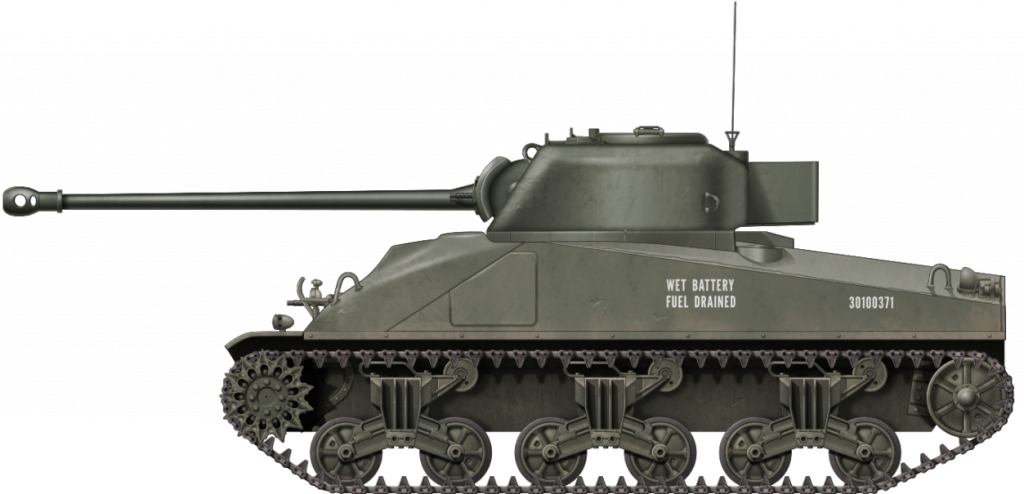
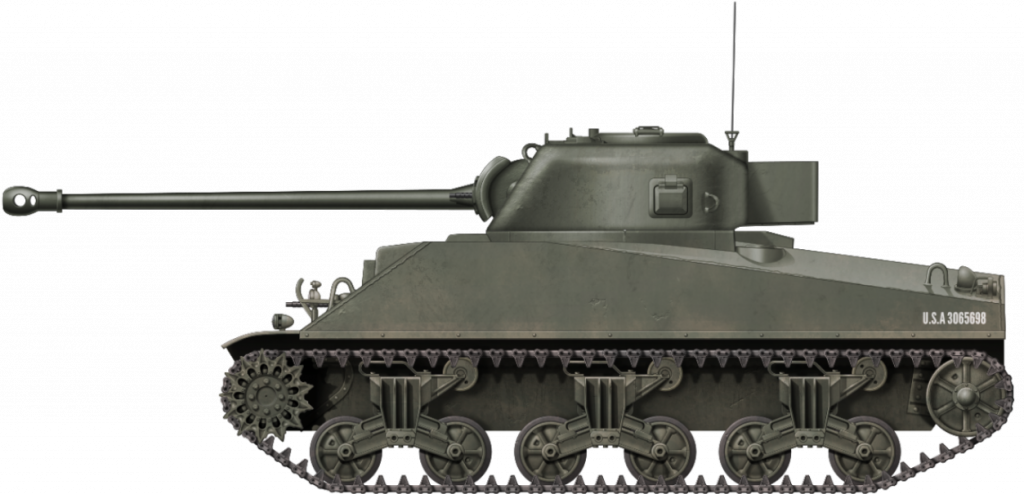
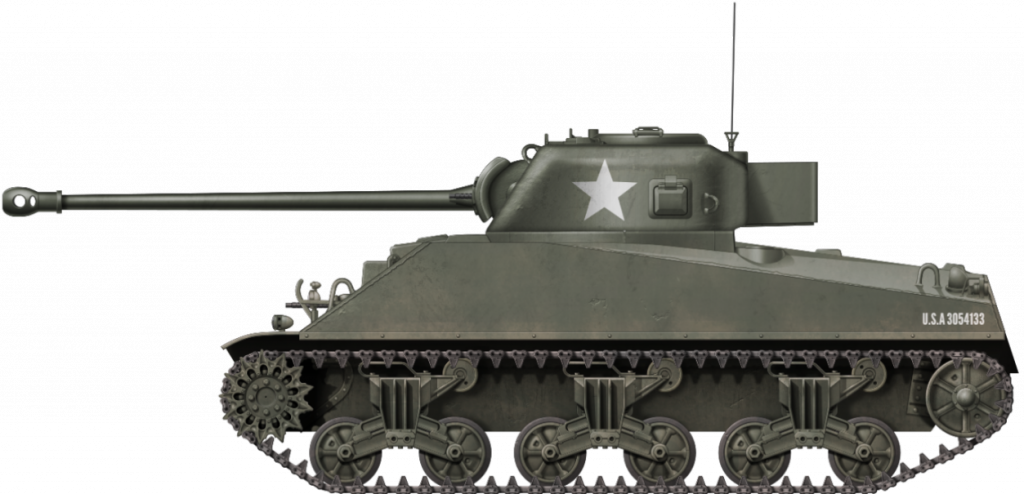
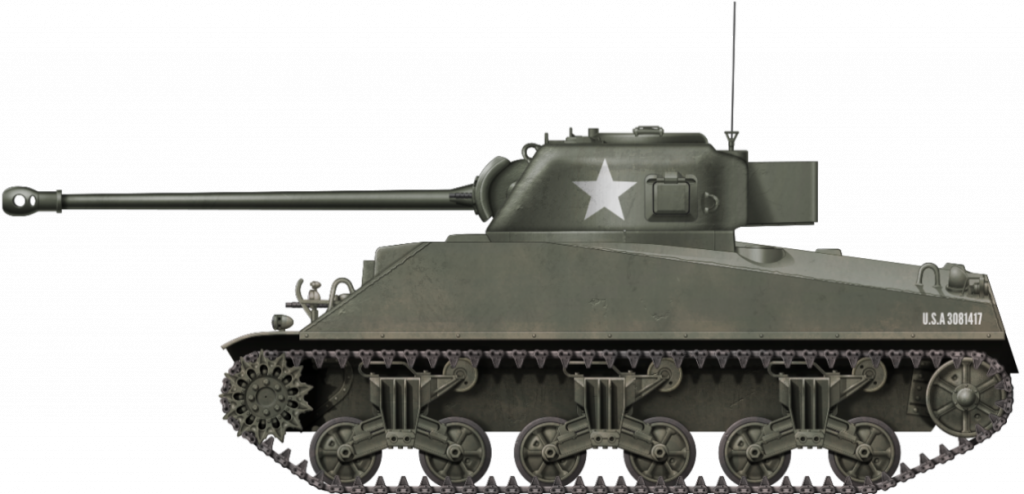
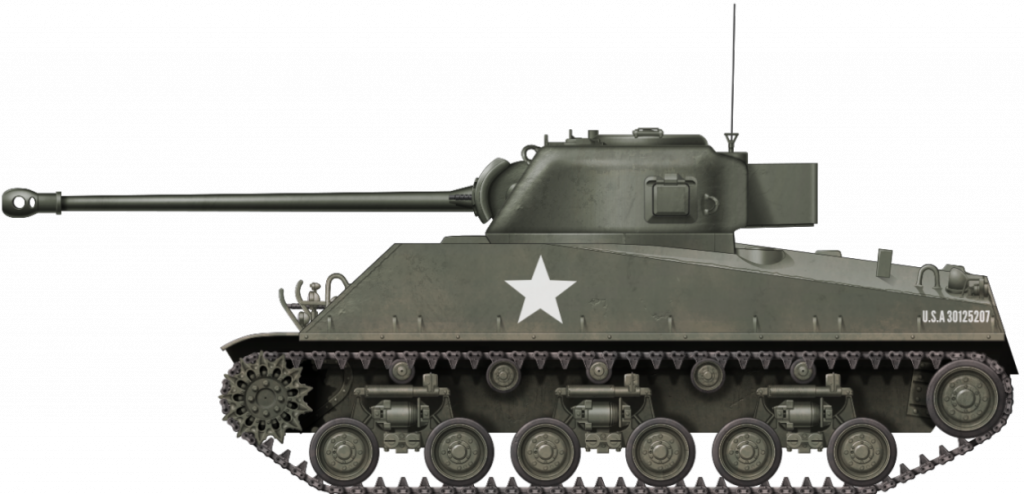
US Firefly specifications |
|
|---|---|
| Dimensions (L/w/h) | Overall Length 7.82 m (307 in) Hull Length 6.5 m (256 in) Width 2.67 m (105 in) Height 2.64 m (104 in) |
| Total weight, battle ready | Approximately: M4 33,455 kg M4A3(75) Wet 34,800 kg |
| Crew | 4 (commander, driver, gunner, loader) |
| Propulsion | M4: R975 M4A3: Ford GAA |
| Suspension | VVSS and HVSS |
| Top speed | Approximately: M4 34 km/h (21 mph) sustained 39 km/h (24 mph) dash M4A3 36 km/h (22 mph) sustained 42 km/h (26 mph) dash |
| Range (road) | Approximately: M4 120 km (190 mi) on road M4A3 210 km (130 mi) on road |
| Armament | OQF 17 Pdr Mk IV 76.2 mm (3 in) 77 rounds Roof mounted M2 12.7 mm (0.5 in) Coaxial 7.62 mm (0.3 in) M1919A4 |
| Armor | 12.7 to 177.8 mm (0.50 to 7.00 in) |
| Total production | 100, it is not known if this is included in the total amount of Fireflies produced |
Sources
Primary sources
Special thanks to Steven J Zaloga for providing some original documents regarding these vehicles.
A series of Teleprint messages sent from Colonel Ordnance Department, Ordnance Officer, T. F. Donahue in the UK to Chief Ordnance Officer HQ ETOUSA Major I. D. Bren. The dates range from 30 March 1945 to 12 May 1945.
US technical manuals
TM9-752 TANK MEDIUM M4A3-44
TM9-759 Tank Medium, M4A3 1944
TM9-1731B OM Ford Tanks Engines Models GAA GAF and GAN
TM9-1725 Ordnance Engine Model R975-C4 (Continental) 1944
British archives
WO 229/83 “WO 229. Supplies (Described at item level)”, https://discovery.nationalarchives.gov.uk/details/r/C11131656, 1944 Jan 01 – 1945 Dec 31, pages 896 to 910
Retyped primary sources
Mark Hayward, “Retype of the conversion instructions for: Medium Tanks, M4 M4A3 and M4A3W (w/75mm Gun) – present British Conversion vs., Conversion for U.S. Troops.”, http://web.archive.org/web/20100306120933/http://freespace.virgin.net/shermanic.Firefly/mh5.html, date viewed 25/11/2023.
Nicholas Moran, “The Chieftain’s Hatch: Gen. Barnes Makes a Call”, https://worldoftanks.com/en/news/history/The_Chieftains_Hatch_Barnes_Call, date viewed 2/12/2023
Secondary sources
Partric A. Stansell & Kurt Laughlin, Son of Sherman Volume 1 books 1 and 2, Enfour Publishing Company, 2023
Steven J Zaloga, Armoured Thunderbolt: the US Army Sherman in World War II, Stackpole books, 2008
David Fletcher, Sherman Firefly, Osprey Publishing, 2008
Micheal Franz, “US WW2 M4/M4A1 Sherman Medium Tank”, Tankograd Publishing, 2005
Richard C. Anderson Jr, (excerpt from, with listed sources) American Thunder, https://www.tapatalk.com/groups/missinglynx/viewtopic.php?p=1713723#p1713723, posted 25/08/2023, date viewed 25/11/2023
Mark Hayward, “SHERMAN M4 AND M4A3 17 POUNDER IN US SERVICE. NEW INFORMATION.”, http://web.archive.org/web/20091215125220/http://freespace.virgin.net/shermanic.Firefly/usnew.html, date viewed 04/01/2024
Nicholas Moran known as The Chieftain, “US AFV Development in WW2, or why the Sherman was as it was”, https://www.youtube.com/watch?v=MVqcQqmA3t0, date viewed 25/11/2023
Pierre-Olivier Buan, Joe DeMarco and Leife Hulbert, “Sherman Driver’s Hoods and Hatches”, http://the.shadock.free.fr/sherman_minutia/hoods_hatches/hoods_hatches.html date viewed 27/11/2023
Pierre-Olivier Buan, Joe DeMarco and Leife Hulbert, “The Sherman M4 Medium Tank: Not the First Type into Production”, Sherman mantua, https://www.theshermantank.com/the-sherman-tank-variant-page-pages-for-each-type-of-sherman-tank/the-sherman-m4-medium-tank-not-the-first-type-into-production/, date viewed 2/12/2023
Pierre-Olivier Buan, Joe DeMarco and Leife Hulbert, “The Sherman M4A3 Medium Tank.”, Sherman mantua, https://www.theshermantank.com/the-sherman-tank-variant-page-pages-for-each-type-of-sherman-tank/the-sherman-m4a3-medium-tank/, date viewed 2/12/2023

